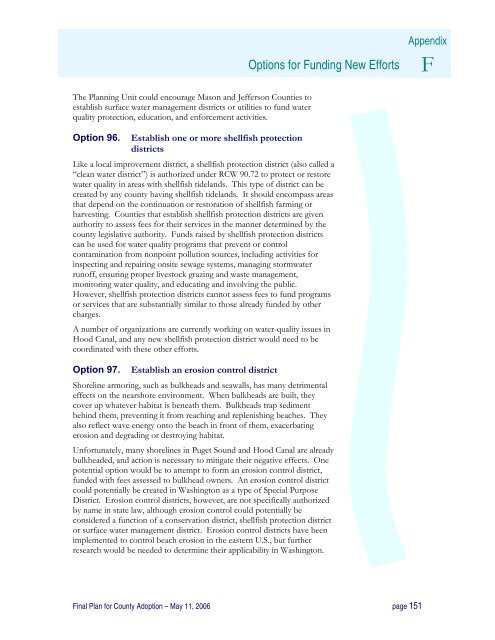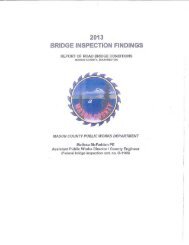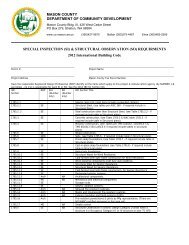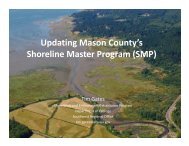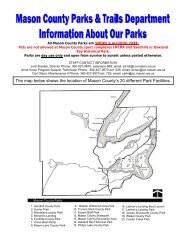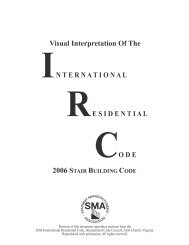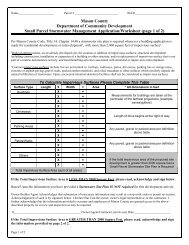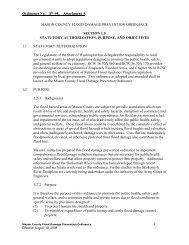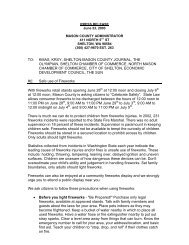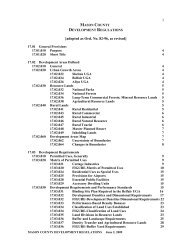Watershed Management Plan - Mason County
Watershed Management Plan - Mason County
Watershed Management Plan - Mason County
You also want an ePaper? Increase the reach of your titles
YUMPU automatically turns print PDFs into web optimized ePapers that Google loves.
Options for Funding New Efforts<br />
Appendix<br />
F<br />
The <strong>Plan</strong>ning Unit could encourage <strong>Mason</strong> and Jefferson Counties to<br />
establish surface water management districts or utilities to fund water<br />
quality protection, education, and enforcement activities.<br />
Option 96.<br />
Establish one or more shellfish protection<br />
districts<br />
Like a local improvement district, a shellfish protection district (also called a<br />
“clean water district”) is authorized under RCW 90.72 to protect or restore<br />
water quality in areas with shellfish tidelands. This type of district can be<br />
created by any county having shellfish tidelands. It should encompass areas<br />
that depend on the continuation or restoration of shellfish farming or<br />
harvesting. Counties that establish shellfish protection districts are given<br />
authority to assess fees for their services in the manner determined by the<br />
county legislative authority. Funds raised by shellfish protection districts<br />
can be used for water quality programs that prevent or control<br />
contamination from nonpoint pollution sources, including activities for<br />
inspecting and repairing onsite sewage systems, managing stormwater<br />
runoff, ensuring proper livestock grazing and waste management,<br />
monitoring water quality, and educating and involving the public.<br />
However, shellfish protection districts cannot assess fees to fund programs<br />
or services that are substantially similar to those already funded by other<br />
charges.<br />
A number of organizations are currently working on water-quality issues in<br />
Hood Canal, and any new shellfish protection district would need to be<br />
coordinated with these other efforts.<br />
Option 97.<br />
Establish an erosion control district<br />
Shoreline armoring, such as bulkheads and seawalls, has many detrimental<br />
effects on the nearshore environment. When bulkheads are built, they<br />
cover up whatever habitat is beneath them. Bulkheads trap sediment<br />
behind them, preventing it from reaching and replenishing beaches. They<br />
also reflect wave energy onto the beach in front of them, exacerbating<br />
erosion and degrading or destroying habitat.<br />
Unfortunately, many shorelines in Puget Sound and Hood Canal are already<br />
bulkheaded, and action is necessary to mitigate their negative effects. One<br />
potential option would be to attempt to form an erosion control district,<br />
funded with fees assessed to bulkhead owners. An erosion control district<br />
could potentially be created in Washington as a type of Special Purpose<br />
District. Erosion control districts, however, are not specifically authorized<br />
by name in state law, although erosion control could potentially be<br />
considered a function of a conservation district, shellfish protection district<br />
or surface water management district. Erosion control districts have been<br />
implemented to control beach erosion in the eastern U.S., but further<br />
research would be needed to determine their applicability in Washington.<br />
Final <strong>Plan</strong> for <strong>County</strong> Adoption – May 11, 2006 page 151


